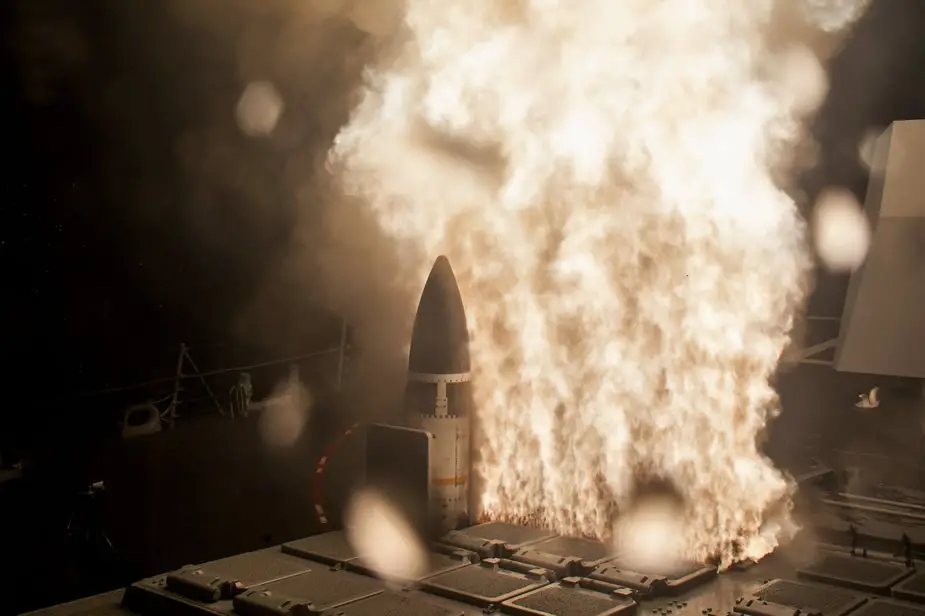The U.S. Missile Defense Agency (MDA), and U.S. Navy sailors aboard USS John Finn (DDG-113) successfully conducted an intercept of a medium-range ballistic missile target with a Standard Missile-3 (SM-3) Block IIA missile during a flight test off the west coast of Hawaii.
The U.S. Missile Defense Agency (MDA), and U.S. Navy sailors aboard USS John Finn (DDG-113) successfully conducted an intercept of a medium-range ballistic missile target with a Standard Missile-3 (SM-3) Block IIA missile during a flight test off the west coast of Hawaii.
 Oct. 26, 2018 - A target missile was launched from the Pacific Missile Range Facility at Kauai, Hawaii during Flight Test Standard Missile-45. The USS JOHN FINN (DDG-113) detected and tracked the target missile with its onboard AN/SPY-1 radar using the Aegis Baseline 9.C2 weapon system. Upon acquiring and tracking the target, the ship launched an SM-3 Block IIA guided missile which intercepted the target.
Oct. 26, 2018 - A target missile was launched from the Pacific Missile Range Facility at Kauai, Hawaii during Flight Test Standard Missile-45. The USS JOHN FINN (DDG-113) detected and tracked the target missile with its onboard AN/SPY-1 radar using the Aegis Baseline 9.C2 weapon system. Upon acquiring and tracking the target, the ship launched an SM-3 Block IIA guided missile which intercepted the target.
The SM-3 Block IIA is being developed cooperatively by the U.S. and Japan and operates as part of the AEGIS Ballistic Missile Defense system.
On October 26, 2018, the target missile was launched from the Pacific Missile Range Facility at Kauai, Hawaii. The USS John Finn (DDG-113) detected and tracked the target missile with its onboard AN/SPY-1 radar using the Aegis Baseline 9.C2 weapon system. Upon acquiring and tracking the target, the ship launched an SM-3 Block IIA guided missile which intercepted the target.
“This was a superb accomplishment and key milestone for the SM-3 Block IIA return to flight,” said MDA Director Lt. Gen. Sam Greaves. “My congratulations to the entire team, including our sailors, industry partners, and allies who helped achieve this milestone.”
"This second intercept for the SM-3 Block IIA is a success we share with the Missile Defense Agency and the country of Japan, our cooperative development partners," said Dr. Taylor W. Lawrence, Raytheon Missile Systems president. "Together, we are building the most advanced solutions for ballistic missile defense."
The IIA variant has larger rocket motors and a bigger kinetic warhead, raising its effectiveness against evolving threats. SM-3 is the only ballistic missile interceptor that can be launched at sea and on land.
"This test authenticates the strengthening global security of the United States and its allies as we deepen the defense capabilities with the Aegis Ballistic Missile Defense System," said Paul Klammer, director, Aegis BMD. "This exercise showed that Aegis is the most advanced combat system and the proven choice for a layered defense."
This test builds upon joint research investments by the United States and Japan and comes on the heels of a successful test with the JS ATAGO (DDG 177) in September. Lockheed Martin is developing a Baseline 9/BMD 5.1 variant computer program, for deployment on Japan's Aegis destroyers.
Based on observations and initial data review, the test met its objectives. Program officials will continue to evaluate system performance.
Aegis Ballistic Missile Defense is the naval component of the U.S. Ballistic Missile Defense System. The MDA and the U.S. Navy cooperatively manage the Aegis BMD program. The Missile Defense Agency's mission is to develop and deploy a layered Ballistic Missile Defense System to defend the U.S., its deployed forces, allies and friends from ballistic missile attacks of all ranges in all phases of flight.







